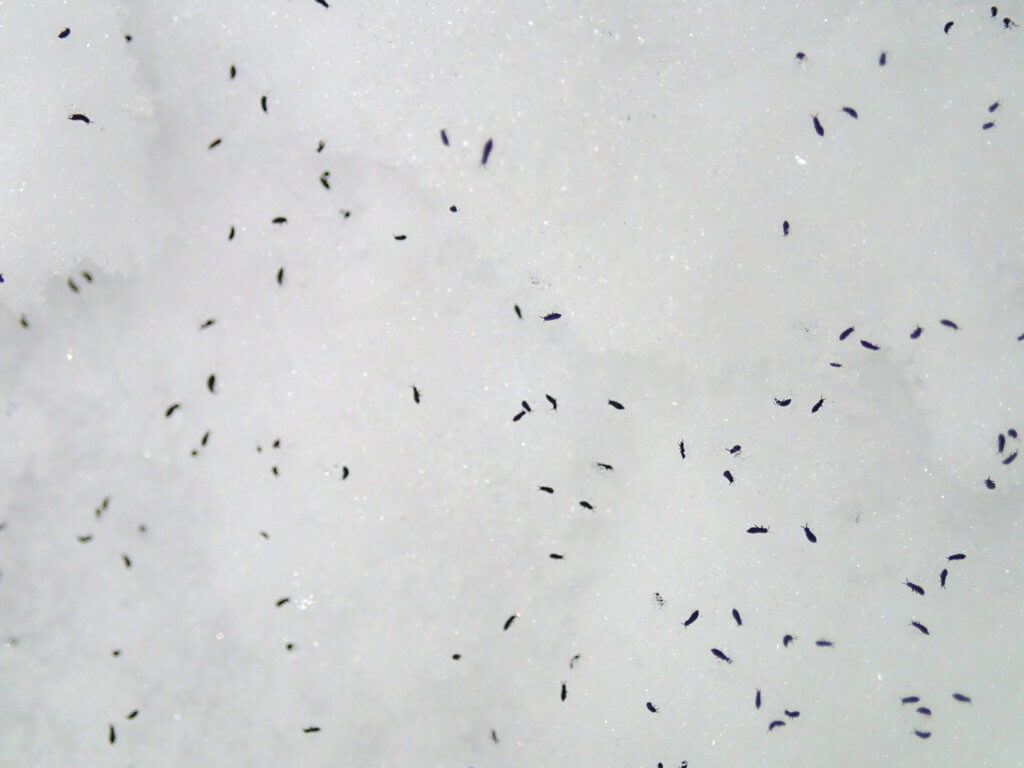Snow Fleas: 400 Million Years Old And Still Springing
by Nicholas Littman
Broadcast 4.15.2015

Snowfleas on snow. Photo by Robbie Sproule (CC 2.0).
Listen:
“Oooo…the poor snow fleas,” says my fiancée, Paige, crouching on the ice to see them closer. “It’s a snow flea massacre, a snow flea disaster!” she exclaims, throwing her hands in the air.
I smile. This is why I’m marrying her later this year – she reminds me to stop and look at the snow fleas.
It’s 48 degrees on the 26th of January in western Montana, and the fleas, no more than specks of dirt to the naked eye, are streaming down rivulets in the icy road and pooling in inky masses that look like miniature peat bogs.
The snow fleas are dying by the thousands right in front of us. The unseasonable weather has prompted them out of their temperate homes in the topsoil. Many won’t make it back. They’ve come too far from the circles of needles and duff near the trees. They’re hopelessly lost on the canvas of white.
If I looked closer, got down on my hands and knees on the ice, scooped a finger into the dark blue flotsam of fleas, and placed one or two under a magnifying glass, I’d find that what we’re witnessing is not the mass death of the loathsome, dog-chewing, bed-infesting siphonaptera, which as a dog owner I would heartily endorse, but the demise of an oft-overlooked hexapod: the springtail.
Paige has been calling them snow fleas, a common name for them, because they jump. But they don’t use their legs to jump like the flea. They spring off their spring-loaded furcula, held in place by the hook of a retinaculum, because unlike what Tigger taught us, you can’t actually spring off a tail.
The springtails’ only similarity with the flea is their size: they’re both 1 to 2 millimeters long. Springtails aren’t true insects; they’re hexapods and have been around for twice as long as the flea, over 400 million years. They’re also far more numerous than fleas. Their subclass Collembola is one of the most abundant macroscopic organisms on earth – up to 100,000 specimens can be found in one square meter of soil, munching away at organic matter.
When I learn of their abundance, I’m not as heartbroken about thousands or millions of springtails littering the snow. But it does alarm me that so many are out at the end of January. Springtails are amazingly cold tolerant; they produce an antifreeze protein that keeps ice crystals from attaching to their exoskeleton. Antarctic relatives can stay alive and active at temperatures down to -38 degrees Fahrenheit. However, they tend to remain in the insulating soil unless it’s warm enough to try their luck on the snow searching for decaying plant matter to eat. I’ve seen them after wet snows or on sunny days in April and November, but now they’re out in higher numbers than ever before in January.
I’m dismayed. As much as I love sitting outside on a Sunday afternoon in January in Montana and reading a book, I also like snow. I like cold and snow during the season when these things are supposed to come because it means Paige and I can go on long rambling ski trips without worrying about ice and rocks. But more importantly, it means the Bitterroot Mountains have been heaped with snow that will not melt until summer, and the hills will stay green through June, and the rivers will keep flowing through August, and there will not be horrendous fires and choking smoke when Paige and I are married in the Bitterroot Valley in September.
I hoped on that day in January that I wouldn’t see the snow fleas for a month or more, that inches or feet of snow would pile in, and the cold would keep them from springing to the surface.
But February and March were warmer than January and brought no snow. Now, in April, if I want to find the little buggers, I have to root around in the soil for them. And I have been rooting around in the soil earlier than usual, because if I can’t have a good winter, at least I’ll have my best garden yet. And while I’m digging and planting, I can thank the snow fleas for chewing away, making my soil rich, black, and loamy.
Every week since 1991, Field Notes has inquired about Montana’s natural history. Field Notes are written by naturalists, students, and listeners about the puzzle-tree bark, eagle talons, woolly aphids, and giant puffballs of Western, Central and Southwestern Montana and aired weekly on Montana Public Radio.
Click here to read and listen to more Field Notes. Field Notes is available as a podcast! Subscribe on iTunes, Google Play, or wherever you listen to podcasts.
Interested in writing a Field Note? Contact Allison De Jong, Field Notes editor, at adejong [at] montananaturalist [dot] org or 406.327.0405.
Want to learn more about our programs as well as fun natural history facts and seasonal phenology? Sign up for our e-newsletter! You can also become a member and get discounts on our programs as well as free reciprocal admission to 300+ science centers in North America!












